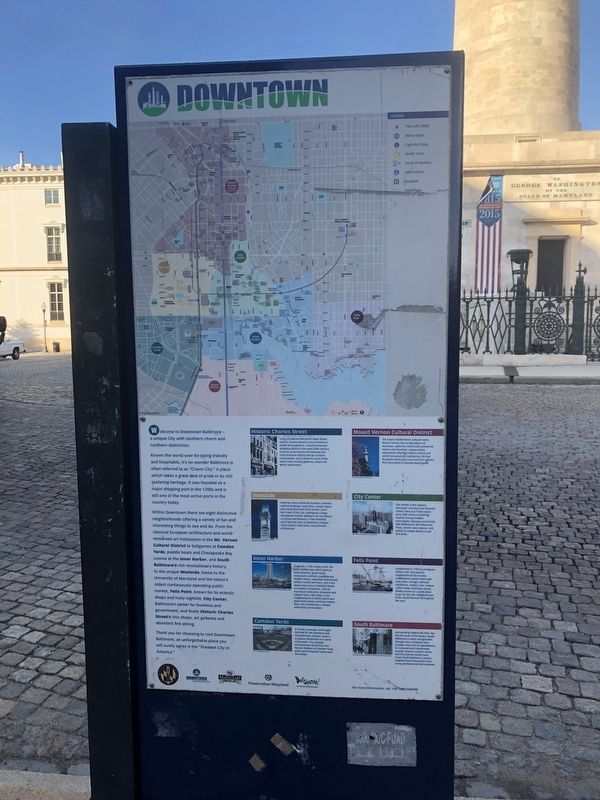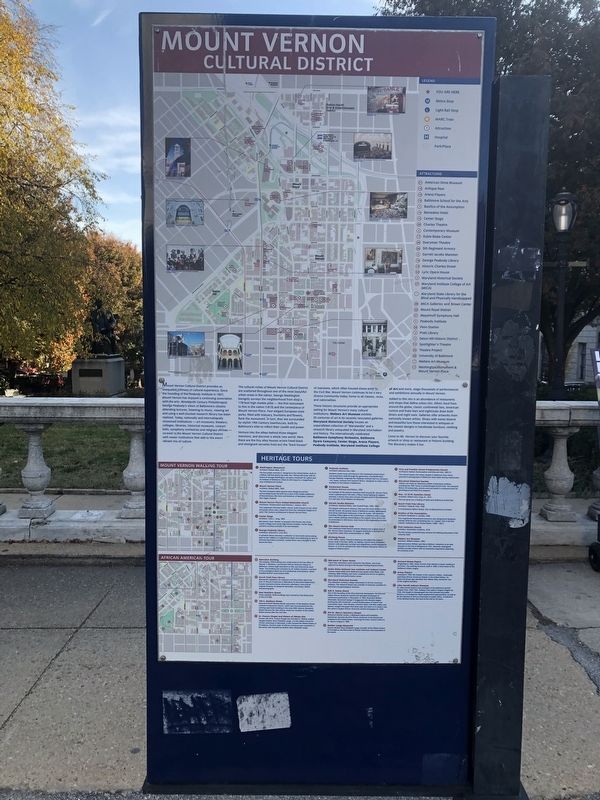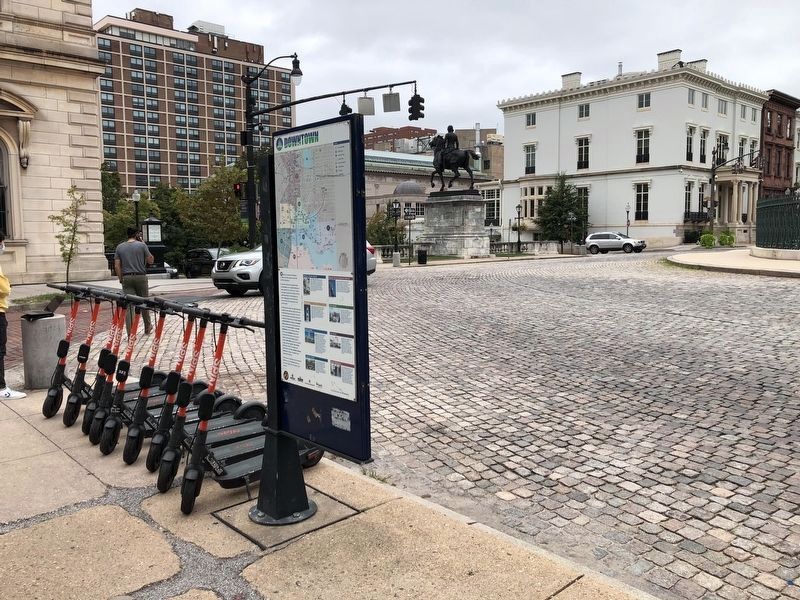Mount Vernon in Baltimore, Maryland — The American Northeast (Mid-Atlantic)
Mount Vernon Cultural District
Mount Vernon Cultural District provides an unequaled richness of cultural experience. Since the founding of the Peabody Institute in 1857, Mount Vernon has enjoyed a continuing association with the arts. Nineteenth Century Philanthropist George Peabody's vision of Baltimore's citizens attending lectures, listening to music, viewing art and using a well-stocked research library has been realized. Today, nationally and internationally renowned institutions — art museums, theaters, colleges, libraries, historical museums, concert halls, symphony orchestras and religious shrines — co-exist in the Mount Vernon Cultural District with newer institutions that add to the area's vibrant mix of culture.
The cultural riches of Mount Vernon Cultural District are scattered throughout one of the most beautiful urban areas in the nation. George Washington benignly surveys the neighborhood from atop a 178-foot high marble pillar — the first monument to him in the nation (1815) and the centerpiece of Mount Vernon Place. Four elegant European-style parks, filled with statuary, fountains and flowers, flank the monument. In turn, they are surrounded by stylish 19th Century townhouses, built by Baltimore's elite to reflect their wealth and power.
Venture into alleys behind these elegant mansions, and discover a whole new world. Here there are the tiny alley houses where freed black and immigrant servants lived and the "back houses" of mansions, which often housed slaves prior to the Civil War. Mount Vernon continues to be a very diverse community today, home to all classes, races and nationalities.
These historic structures provide an appropriate setting for Mount Vernon's many cultural institutions. Walters Art Museum exhibits 55 centuries of art in its recently renovated galleries. Maryland Historical Society houses an unparalleled collection of "Marylandia" and a research library unequaled in Maryland information and history. The internationally celebrated Baltimore Symphony Orchestra, Baltimore Opera Company, Center Stage, Arena Players, Peabody Institute, Maryland Institute College of Art and more, stage thousands of performances and exhibitions annually in Mount Vernon.
Added to this mix is an abundance of restaurants and shops that define urban chic. Ethnic food from around the globe, classic continental fare, American cuisine and lively bars and nightclubs draw both diners and night owls. Galleries offer artworks from nationally known artists. Shops with wares bizarre and beautiful lure those interested in antiques or the newest design in handmade furniture, clothing and jewelry.
Come to Mt. Vernon to discover your favorite

Photographed By Devry Becker Jones (CC0), November 9, 2019
2. Mount Vernon Cultural District Marker
Reverse
Heritage Tours
Mount Vernon Walking Tour
1. Washington Monument
Architect: Robert Mills, 1815
The first public monument designed in the United States, built on a hilltop 100 feet above sea level, the 178-foot tall tower with its statue of George Washington, became a landmark for sailors and an emblem of Baltimore. Climb its 225 steps for a magnificent view of Baltimore's harbor.
2. Mount Vernon Place
Architect: Robert Mills, 1829
The four European-style squares were designed and the surrounding house lots laid out as part of the estate settlement of Revolutionary War hero and Governor of Maryland, Colonel, John Eager Howard.
3. Mount Vernon Place United Methodist Church
Architects: Thomas Dixon and Charles L. Carson, 1873
This exuberant Victorian Gothic church, built in layers of red, white and green stone, was a departure from the restrained elegance of early 19th Century architecture in Mount Vernon Place.
4. Center Stage
Architect: Louis L. Long, 1856
Maryland's State Theater is housed in this former site of the Loyola College and Loyola High School complex. Center Stage presents six plays annually in its two theaters.
5. George
Architects: Edmund G. Lind, 1876
A scholarly library housing a collection of rare books (some dating back to the 1400s) in a magnificent stack room featuring six tiers of intricate decorative ironwork, marble floors and a skylight 61 feet above the floor.
6. Peabody Institute
Architect: Edmund Lind, 1860
Students study music and dance in this renowned conservatory and preparatory built through the generosity of philanthropist George Peabody. Originally the Peabody Institute had four divisions—art, music, lectures and research library—designed to make culture available to the citizens of Baltimore.
7. Hackerman House
Architects: Niernsee and Nielsen, 1850
An example of the opulent mansions built around Mt. Vernon Place, it has a palatial entry hall with a Tiffany dome lighting its elegant stairway, a secret room and a former terrapin pond in the basement. It is now part of the Walters Art Museum.
8. Garrett Jacobs Mansion
Architects: Sanford White, John Russell Pope, 1884, 1902
The largest rowhouse in America, this was the home of Mary Frick Garrett Jacobs, the grande dame of Baltimore society. Redesigned from three individual rowhouses, it has 40 rooms, 100 windows including Tiffany glass in the Grand Foyer, a ballroom with a state and a marble stairway descending to the supper room, which can accommodate to 200 diners. Now home to the Engineering Society of Baltimore.
9. The Mount Vernon Club
This unaltered Greek Revival exterior displays the original style of Mt. Vernon Place mansions. Its elegant simplicity is derived from proportion rather than ornamentation. (c. 1840)
10. Marburg House
In the 1890s, owner Theodore Marburg remodeled the original house, built in the late 1840s, by adding a fourth story, limestone exterior with elaborate carvings and magnificent carved woodwork interior. In 1915 he worked here with President Woodrow Wilson on League of Nations plans.
11. First and Franklin Street Presbyterian Church
Architects: Nathan Starkweather and Edmund Lind, 1853-74
This church boasts the tallest steeple in Baltimore from which panoramic photographs of Baltimore were taken during construction.
12. Maryland Historical Society
Visitors can enjoy an extensive exhibit of Maryland artifacts, including the 1847 home of philanthropist Enoch Pratt. The research library of manuscripts, photos and rare books is a treasure trove for genealogical and historical research.
13. Nos. 12-18 W. Hamilton Street
Architect: Robert Cary Long, Sr., 1815
This row gives you a feeling of what early Baltimore looked like.
14. Enoch Pratt Free Library
Architect Clyde M. Fritz, 1933
A revolutionary library design, that invited patrons to browse.
15. Basilica of the Assumption
Architect: Benjamin H. Latrobe, 1806
This magnificent Neoclassical structure was designed by Benjamin Latrobe while he was completing the U.S. Capitol. This is the first Catholic Cathedral in the United States. (1806-1821)
16. First Unitarian Church
Architect: Maximilian Godefroy, 1818
The first sermon preached here remains the defining document of the Unitarian faith.
17. Walters Art Museum
Architect: William Delano, 1904
Railroad barons William and Henry Walters' collection of art was donated to the City of Baltimore in 1931. Recently redesigned exhibits provide visitors with an interactive experience exploring 55 centuries of art.
African American Tour
1. Banneker Building
The existing 1903 building was constructed as the law office of Warner T. McGuinn, a prominent African American lawyer in Baltimore, whose legal education at Yale was financed by Mark Twain. The building was overseen by W. Ashbie Hawkins, a partner in the prestigious black law firm McMechen and Hawkins, which handled NAACP cases before WWI.
2. Enoch Pratt Free Library
Maryland's repository for research ain information about the lives of African Americans in Maryland, its Maryland Department houses extensive African American collections, including an original Almanac by Benjamin Banneker, rare books, letters and photographs.
3. East Hamilton Street
These existing 1840s buildings were owned by free blacks prior to the Civil War.
104 E. Madison Street
Reverend Hiram Rhodes Revels was pastor of the Madison Street Colored Presbyterian Church, which was incorporated into the existing apartment building in the early 20th century. Reverend Revels became the first African American member of the United States Senate after the Civil War.
5. St. Francis Chapel and Sisters of Oblate Site
Former site of St. Francis Chapel was founded in 1828 by Haitian refugee Mother Mary Elizabeth Lange. It is the oldest school for African Americans in Maryland. It also housed the Oblate Sisters of Providence, the first order of African American nuns anywhere in the world, also founded by Mother Mary Elizabeth Lange.
6. 800 block of Tyson Street
These tiny rowhouses were owned by free blacks, who lived adjacent to slaves serving in the houses fronting Howard Street.
7. Eubie Blake National Jazz Institute and Cultural Center
Houses memorabilia from Baltimore jazz greats Euble Blake, Cab Calloway, Billie Holliday and more. Located here are and art gallery, music lessons and performance venue.
8. Maryland Historical Society
The collection contains a large assortment of African American artifacts. The research library has a wealth of materials available for historical and genealogical research.
9. 628 N. Eutaw Street
Site of the founding of the Afro-American Newspaper, the first and oldest African American owned and operated newspaper in continuous publication in Maryland. In 1892, Reverend William Alexander, Reverend George F. Bragg and John Murphy began printing the Afro-American, a small weekly paper of church and community news. John Murphy, a former slave, Civil War soldier and laborer, bought the paper that same year and went on to build it into the nation's largest African American owned newspaper by 1922.
10. Old St. Mary's Seminary Chapel
Reverend Charles Uncles, a Baltimore native and Josephite seminarian, became the first African American to be trained and ordained in the United States, receiving his minor clerical orders in St. Mary's Chapel in 1890.
11. Mother Lange Memorial
Honors Mother Mary Elizabeth Lange, founder of the Oblate Sisters of Providence, the first order of African American nuns anywhere in the world.
12. Orchard Street Church
Originated in 1825, when Truman Pratt started a prayer meeting in his home. The existing structure, built in 1882, is now home to the Baltimore Urban League.
13. Arena Players
Founded in 1952, the theater is the country's oldest, continually operating African American theater in the United States. An historical street sign identifies Sam Wilson Way, named for one of the original founders.
14. Lillie Carroll Jackson Museum
Dr. Lillie Carroll Jackson was president of the Baltimore NAACP chapter from 1935-1969, making it the nation's largest chapter by 1946. She fought to desegregated the City's private and public facilities and worked for equal employment opportunities, as well as for the election of African-Americans to public office. A matriarch of the Mitchell family, she lived at the site for 25 years.
[Reverse:]
Downtown
Welcome to Downtown Baltimore — a unique City with southern charm and northern distinction.
Known the world over for being friendly and hospitable, it's no wonder Baltimore is often referred to as "Charm City." A place which takes a great deal of pride in its rich seafaring heritage, it was founded as a major shipping port in the 1700s and is still one of the most active ports in the country today.
Within Downtown there are eight distinctive neighborhoods offering a variety of fun and interesting things to see and do. From the classical European architecture and world-renowned art institutions in the Mt. Vernon Cultural District to ballgames at Camden Yards, paddle boats and Chesapeake Bay cuisine at the Inner Harbor, and South Baltimore's rich revolutionary history, to the unique Westside, home to the University of Maryland and the nation's oldest continuously-operating public market, Fells Point, known for its eclectic shops and lively nightlife, City Center, Baltimore's center for business and government, and finally Historic Charles Street's chic shops, art galleries and abundant fine dining.
Thank you for choosing to visit Downtown Baltimore, an unforgettable place you will surely agree is the "Greatest City in America."
Historic Charles Street
Long considered Baltimore's Main Street, Historic Charles Street is one of America's oldest thoroughfares. A world-renowned shopping district in the early 20th Century, it serves as an historic link between the City's business district and its northern communities, and is home to some of the area's most exciting galleries, shops and ethnic restaurants.
Westside
Amid the many university students, eminent medical buildings, funky lofts, unique stores and world-renowned food market, you'll find a part of the City undergoing a huge renaissance further adding to its rich history of culture and diversity. In the Westside you'll find the roots of Baltimore's famous retail industry and classic centuries-old architecture.
Inner Harbor
Originally a 17th century port, the Inner Harbor now offers open-air entertainment, great shops, restaurants and bars, paddleboats, dolphin shows, seasonal celebrations, harbor cruises and more. Just a few steps away across President Street are Historic Jonestown, with its numerous landmarks, museums and cultural sites; Little Italy, a cozy neighborhood of ethnic charm and great restaurants; and Inner Harbor East, one of Baltimore's newest waterfront communities.
Camden Yards
A former passenger and freight terminal for the Baltimore and Ohio Railroad, Camden Yards is a popular destination for sports enthusiasts. The complex encompasses Oriole Park and Ravens Stadium at Camden Yards, great sports-inspired restaurants and shops.
Mount Vernon Cultural District
The heart of Baltimore's cultural realm, Mount Vernon has an abundance of museums, galleries, historically preserved homes and churches, unique shops, restaurants offering eclectic cuisine and world-renowned art institutions. Its four European-style parks surround the nation's first monument to George Washington.
Fells Point
Established in 1730 by immigrant William Fell, this popular neighborhood has narrow cobblestone streets lines with cozy pubs, lovingly restored residences, historic inns, unique coffee shops and funky stores. Widely known as a great place to go for fun, the neighborhood hosts street festivals throughout the year.
South Baltimore
Surrounding Federal Hill Park, the big hill south of the harbor, South Baltimore is easily recognizable. Though many residents have proudly lived here for generations, its restored brick townhomes, popular taverns eclectic stores and City-owned market have made South Baltimore a trendy neighborhood among the City's young professionals and students.
Erected by City of Baltimore; Downtown Partnership; Maryland Heritage Area Authority; Preservation Maryland; Baltimore! Area Convention and Visitors Association.
Topics and series. This historical marker is listed in these topic lists: African Americans • Architecture • Churches & Religion • Settlements & Settlers. In addition, it is included in the Unitarian Universalism (UUism) series list. A significant historical year for this entry is 1857.
Location. 39° 17.85′ N, 76° 36.916′ W. Marker is in Baltimore, Maryland. It is in Mount Vernon. Marker is at the intersection of Washington Place and East Mt. Vernon Place, on the right when traveling north on Washington Place. Touch for map. Marker is in this post office area: Baltimore MD 21202, United States of America. Touch for directions.
Other nearby markers. At least 8 other markers are within walking distance of this marker. Contributing to Society: Baltimore's Best Address (here, next to this marker); Celebrating Culture: The Heart of the City / Contributing to Society: Baltimore's Best Address (a few steps from this marker); Welcome to the Washington Monument and Mount Vernon Place (a few steps from this marker); The Peabody Library (within shouting distance of this marker); The Peabody Conservatory (within shouting distance of this marker); Washington Monument (within shouting distance of this marker); Mount Vernon Place United Methodist Church (within shouting distance of this marker); Francis Scott Key (within shouting distance of this marker). Touch for a list and map of all markers in Baltimore.
Additional keywords. Roman Catholicism, Unitarian Universalism, convents
Credits. This page was last revised on October 11, 2021. It was originally submitted on November 9, 2019, by Devry Becker Jones of Washington, District of Columbia. This page has been viewed 347 times since then and 20 times this year. Last updated on March 16, 2021, by Carl Gordon Moore Jr. of North East, Maryland. Photos: 1, 2. submitted on November 9, 2019, by Devry Becker Jones of Washington, District of Columbia. 3. submitted on October 11, 2021, by Devry Becker Jones of Washington, District of Columbia.

